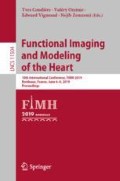Abstract
Reconstructing 3D ventricular surfaces from 2D cardiac MR data is challenging due to the sparsity of the input data and the presence of interslice misalignment. It is usually formulated as a 3D mesh fitting problem often incorporating shape priors and smoothness regularization, which might affect accuracy when handling pathological cases. We propose to formulate the 3D reconstruction as a volumetric mapping problem followed by isosurfacing from dense volumetric data. Taking advantage of deep learning algorithms, which learn to predict each voxel label without explicitly defining the shapes, our method is capable of generating anatomically meaningful surfaces with great flexibility. The sparse 3D volumetric input can process contours with any orientations and thus can utilize information from multiple short- and long-axis views. In addition, our method can provide correction of motion artifacts. We have validated our method using a statistical shape model on reconstructing 3D shapes from both spatially consistent and misaligned input data.
Access this chapter
Tax calculation will be finalised at checkout
Purchases are for personal use only
References
Vukicevic, M., Mosadegh, B., Min, J., Little, S.: Cardiac 3D printing and its future directions. JACC Cardiovasc. Imaging 10, 171–184 (2017)
Suinesiaputra, A., et al.: Statistical shape modeling of the left ventricle: myocardial infarct classification challenge. IEEE JBHI 22(2), 503–515 (2018)
Lehmann, H., et al.: Integrating viability information into a cardiac model for interventional guidance. In: Ayache, N., Delingette, H., Sermesant, M. (eds.) FIMH 2009. LNCS, vol. 5528, pp. 312–320. Springer, Heidelberg (2009). https://doi.org/10.1007/978-3-642-01932-6_34
Zacur, E., et al.: MRI-based heart and Torso personalization for computer modeling and simulation of cardiac electrophysiology. In: Cardoso, M.J., et al. (eds.) BIVPCS/POCUS -2017. LNCS, vol. 10549, pp. 61–70. Springer, Cham (2017). https://doi.org/10.1007/978-3-319-67552-7_8
Arevalo, H., et al.: Arrhythmia risk stratification of patients after myocardial infarction using personalized heart models. Nat. Commun. 7, 11437 (2016)
Deng, D., Zhang, J., Xia, L.: Three-dimensional mesh generation for human heart model. In: Li, K., Li, X., Ma, S., Irwin, G.W. (eds.) ICSEE/LSMS -2010. CCIS, vol. 98, pp. 157–162. Springer, Heidelberg (2010). https://doi.org/10.1007/978-3-642-15859-9_22
AHA Writing Group on Myocardial Segmentation and Registration for Cardiac Imaging: Manuel D. Cerqueira, et al. "Standardized myocardial segmentation and nomenclature for tomographic imaging of the heart: a statement for healthcare professionals from the Cardiac Imaging Committee of the Council on Clinical Cardiology of the American Heart Association." Circulation 105(4), 539–542 (2002)
Villard, B., Zacur, E., Dall’Armellina, E., Grau, V.: Correction of slice misalignment in multi-breath-hold cardiac MRI scans. In: Mansi, T., McLeod, K., Pop, M., Rhode, K., Sermesant, M., Young, A. (eds.) STACOM 2016. LNCS, vol. 10124, pp. 30–38. Springer, Cham (2017). https://doi.org/10.1007/978-3-319-52718-5_4
Zou, M., Holloway, M., Carr, N., Ju, T.: Topology-constrained surface reconstruction from cross-sections. ACM Trans. Graph. 34, 128 (2015)
Young, A., et al.: Left ventricular mass and volume: fast calculation with guide-point modelling on MR images. Radiology 2, 597–602 (2000)
Medrano-Gracia, P., et al.: Large scale left ventricular shape atlas using automated model fitting to contours. In: Ourselin, S., Rueckert, D., Smith, N. (eds.) FIMH 2013. LNCS, vol. 7945, pp. 433–441. Springer, Heidelberg (2013). https://doi.org/10.1007/978-3-642-38899-6_51
Villard, B., Grau, V., Zacur, E.: Surface mesh reconstruction from cardiac MRI contours. J. Imaging 4(1), 16 (2018)
Lamata, P., et al.: An accurate, fast and robust method to generate patient-specific cubic Hermite meshes. Med. Image Anal. 15, 801–813 (2011)
De Marvao, A., et al.: Population-based studies of myocardial hypertrophy: high resolution cardiovascular magnetic resonance atlases improve statistical power. J. Cardiovasc. Magn. Reson. 16, 16 (2015)
Zhang, X., et al.: Atlas-based quantification of cardiac remodeling due to myocardial infarction. PloS One 9(10), e110243 (2014)
Alba, X., et al.: An algorithm for the segmentation of highly abnormal hearts using a generic statistical shape model. IEEE TMI 35(3), 845859 (2016)
Zhang, C., et al.: Understanding deep learning requires rethinking generalization. arXiv preprint arXiv:1611.03530 (2016)
Oktay, O., et al.: Anatomically constrained neural networks (ACNNs): application to cardiac image enhancement and segmentation. IEEE TMI 37(2), 384–395 (2018)
Duan, J., et al.: Automatic 3D bi-ventricular segmentation of cardiac images by a shape-refined multi-task deep learning approach. IEEE TMI (2019)
McLeish, K., Hill, D.L.G., Atkinson, D., Blackall, J.M., Razavi, R.: A study of the motion and deformation of the heart due to respiration. IEEE TMI 21(9), 1142–1150 (2002)
Shechter, G., Ozturk, C., Resar, J.R., McVeigh, E.R.: Respiratory motion of the heart from free breathing coronary angiograms. IEEE TMI 23, 1046–1056 (2004)
Bertalmio, M., Sapiro, G., Caselles, V., Ballester, C.: Image inpainting. In: Proceedings of the 27th Annual Conference on Computer Graphics and Interactive Techniques, pp. 417–424. ACM Press/Addison-Wesley Publishing Co. (2000)
Çiçek, Ö., Abdulkadir, A., Lienkamp, S.S., Brox, T., Ronneberger, O.: 3D U-Net: Learning dense volumetric segmentation from sparse annotation. In: Ourselin, S., Joskowicz, L., Sabuncu, M.R., Unal, G., Wells, W. (eds.) MICCAI 2016. LNCS, vol. 9901, pp. 424–432. Springer, Cham (2016). https://doi.org/10.1007/978-3-319-46723-8_49
Bai, W., et al.: A bi-ventricular cardiac atlas built from 1000+ high resolution MR images of healthy subjects and an analysis of shape and motion. Med. Image Anal. 26, 133–145 (2015)
Milletari, F., Navab, N., Ahmadi, S.A.: V-net: fully convolutional neural networks for volumetric medical image segmentation. In: 4th 3DV, pp. 565–571 (2016)
Lorensen, W.E., Cline, H.E.: Marching cubes: a high resolution 3D surface construction algorithm. In: ACM Siggraph Computer Graphics, vol. 21, no. 4, pp. 163–169. ACM (1987)
Acknowledgments
We thank BHF Project Grant No. PG/16/75/32383 “Improving risk stratification in HCM through a computational anatomical analysis of ventricular remodelling” for support.
Author information
Authors and Affiliations
Corresponding author
Editor information
Editors and Affiliations
Rights and permissions
Copyright information
© 2019 Springer Nature Switzerland AG
About this paper
Cite this paper
Xu, H., Zacur, E., Schneider, J.E., Grau, V. (2019). Ventricle Surface Reconstruction from Cardiac MR Slices Using Deep Learning. In: Coudière, Y., Ozenne, V., Vigmond, E., Zemzemi, N. (eds) Functional Imaging and Modeling of the Heart. FIMH 2019. Lecture Notes in Computer Science(), vol 11504. Springer, Cham. https://doi.org/10.1007/978-3-030-21949-9_37
Download citation
DOI: https://doi.org/10.1007/978-3-030-21949-9_37
Published:
Publisher Name: Springer, Cham
Print ISBN: 978-3-030-21948-2
Online ISBN: 978-3-030-21949-9
eBook Packages: Computer ScienceComputer Science (R0)

